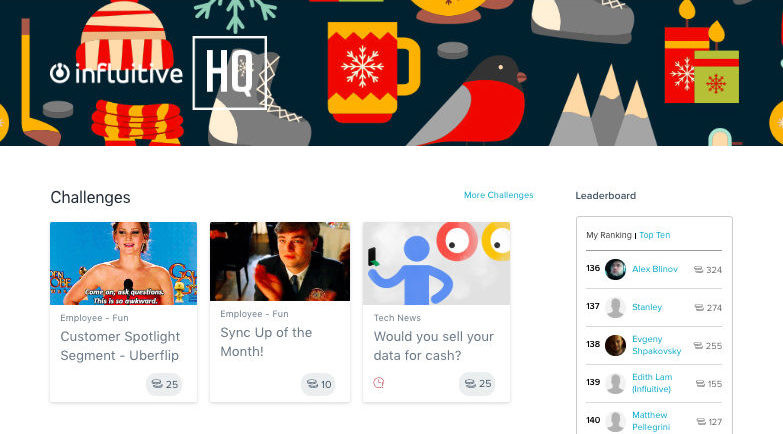Employee advocacy is when employees share positive opinions about your company through word of mouth, both online and in person. It boosts your brand as an employer because the voices of genuinely delighted employees are way more impactful than your company tooting its own horn.

So why is employee advocacy such a big deal, and why should it be a priority for your organization? There are 5 main benefits of having a solid employee engagement strategy. I’ll explain each of them, then share our 14 best tried-and-true tactics for engaging employees in the section below.
1. Employee engagement improves company communication and education
Better education on company news fosters a sense of unified purpose. An employee advocacy program helps solidify company learning and culture. News travels faster—people talk about the company’s successes and product launches. Plus, employees are more likely to understand and communicate the company’s value. In the best-case scenario, employees share more news from their own departments, answer each others’ questions, and boost morale by recognizing each other in front of your whole company.
2. Your employees can refer new customers
A chorus of employee voices is always louder and resonates more than a company’s marketing alone. When you empower and educate employees to talk about your solution, they’re more likely to spread the word when opportunities present themselves. For example, through personal connections, at events, or on social media. This helps marketing teams earn more public mindshare and attract more leads.
3. Sourcing new talent through referrals saves money on recruiting
When employees refer their friends and colleagues for open roles, these tend to be highly qualified and successful candidates. Applicants who start as referrals are more likely to be hired and have longer tenures.
Drawing on the talented network of your employee base means your company doesn’t have to spend as much working with recruiters to source all stars. Our team has to spend less time screening candidates, and they have better offer acceptance rates. Plus, employees who began as referrals tend to give higher satisfaction scores once they join.
4. Happy employees help attract and sign applicants
Thrilled employees generate authentic social proof that money can’t buy. A company can tell others that it’s a great organization to work for and with, but only its employees’ actions can genuinely show it. When employees are truly delighted, their reviews on recruitment sites like Glassdoor are more effusive, their interviews with applicants are more fun, and they generate a public cachet that helps with sales and recruiting.
5. Strong employee advocacy boosts employee retention
When employees are so delighted with their experience that they say positive and exciting things in public, all employees feel more engaged and loyal. And loyalty matters big time. Last year, employers paid $600 billion replacing dissatisfied employees who quit. (Read more about how to train your employees to be brand ambassadors here.)
Sounds great so far, right? It is. So where do you begin in order to set up a successful employee advocacy initiative?
Tips for encouraging employees to be advocates
1. Establish goals for your advocate program
Before you ask anything of your employees, consider what you want to accomplish. Many organizations begin by identifying a challenge they’re facing, such as a lack of qualified applicants or a lack of engagement on social media, and then set metrics to reach that goal. For instance, these metrics could be the percentage of employees who refer friends or total employee-generated social shares.
Goals you might consider:
- Increase employee satisfaction rating
- Increase ratings on employer review sites such as Glassdoor
- Increase the reach of marketing programs
- Create more interdepartmental alignment
- Make town hall meetings more informative and exciting
How we do it at Influitive
Our main goal is to keep employees engaged, which we define as visiting our advocate community 3 times per week and completing at least 1 act of advocacy per week. For each engagement campaign we run, we set target completion rates, such as 75% for surveys.

A peek inside Influitive HQ, our employee advocacy program
2. Get your executives bought in
A great way to kickstart interest in an employee advocacy program is to enlist executive support and have someone like your CEO emphasize its importance. This is because employee engagement programs benefit from a network effect. The more people participate, the more others want to be involved.
How do you get buy-in, exactly? Present the goals of your program and the metrics by which you’ll measure them in terms of a challenge the company is already trying to solve. For example, helping the head of HR with that retention problem they mentioned at the last all-hands meeting. Framing the project in terms of solving costly problems is most likely to garner the buy-in and budget needed to make it successful.
How we do it at Influitive
As an advocacy software company, our CEO and founder Mark Organ is so on board with the idea of harnessing advocates, he wrote a whole book about it. (Perhaps your executives need a copy!) We also involve all members of our senior leadership team in setting OKRs for the program.
3. Let employees tell their stories and encourage an open, honest discussion
Few companies give employees a digital water cooler to talk openly about whatever they want, even though many crave this opportunity. Often, the reason has to do with communication platforms.
Most companies rely on email, intranets, and chat platforms to communicate information. While these formats are easy for senders, they rarely facilitate community and two-way collaboration. Emails get lost in the inbox, people dread accidentally hitting “reply all,” and intranets are famously a place where good ideas go to hide.
When choosing a channel for your employee advocacy program, pick one that allows people to actively talk with one another. Then, encourage open sharing with prompts. For example, what are employees working on? What do they want others to know? What questions do they have that other employees can answer? These discussions reveal employees’ interests and needs, and help inform the program.
How we do it at Influitive
Our people and culture team is very clear that the program exists to serve employees. We all vote on the program’s purpose and direction, and use it as a place to ask each other for on-the-job help. We initiate a wide variety of discussions through our product—from trading healthy recipes and fitness tips to a monthly AMA (ask me anything) with our CEO.

A look at this month’s AMA with our CEO Mark Organ
4. Kick off your employee advocacy program with a group exercise
Everyone should be involved in creating the program’s culture and making policy decisions, starting with voting on the program’s name and what they want from it.
The naming imparts a sense of ownership. Behavioral economists have long observed that we value things more highly when we own them, and we’re reluctant to part with them. Once your employees feel like founders, they’re more likely to participate in your program.
How we do it at Influitive
We put our own advocate program name up to a vote. Employees decided on “HQ,” reflective of the fact that while we have employees across North America, we’re all a part of company headquarters. This isn’t the only reason for HQ’s 90% participation rate, but it’s certainly a factor.
5. Choose an employee advocacy platform that allows you to reward your employees for their participation
Giving employees a forum to share, tracking their participation, and rewarding them for doing so can take a lot of time and effort. Consider a purpose-built software to make it all easier.
An advocacy software gives communities one single, central place to do everything. It’s a home base where employees can go for training, but also where product teams can announce updates, marketing teams can ask employees to share new blogs, and HR teams can ask for feedback and referrals.
Whatever option you choose, simplicity in design is key. As any company with an intranet that’s fallen into disuse knows, people only engage when it’s easy, fun, and benefits them in some way.
How we do it at Influitive
We use our own software, AdvocateHub, to its maximum potential. It’s home to lively, daily discussions where employees complete challenges to earn points that they can redeem for sweet rewards. For example, when an employee successfully refers a candidate that we hire, they receive a cash bonus, a luxurious dinner on us, plus 15,000 HQ points. Our program also has built-in discussion boards, and robust analytics to track and optimize advocates’ impact.
6. Use gamification techniques to create challenges, rewards, and incentives for advocate initiatives
Reward employees for completing challenges such as sharing a company article on their personal Twitter, completing a certification, or voting on discussion topics for the next company meeting.
For rewards to work, they have to be thoughtful. People can spot lazy prizes. Think beyond the catchall gift card and reward employees with training that aids their careers (also good for the company), warms their hearts, or fills their stomachs.
How we do it at Influitive
We allow employees to make donations to charities of their choice, reimburse meals, cover travel costs, and help break down departmental silos by granting them a dinner with people like Mark, our CEO.
7. Allow employees to recognize one another
To literally multiply the effectiveness of your prizes, make the gift giving peer-to-peer. Consider incorporating unique custom awards into your recognition program, tailored to celebrate individual accomplishments and contributions, thereby creating a sense of pride and motivation among employees.
One leading marketing automation company allows employees to periodically award each other with $25 gift cards as a way to say thanks. When they share a gift card, it triggers a public post about it on LinkedIn.
How we do it at Influitive
We use our employee advocacy program to encourage and remind employees to recognize one another for going above and beyond. We create challenges where employees can submit a blurb about an exceptional coworker, which they’ll read out in front of our whole company at our daily standups.
We also vote through HQ each quarter to crown a “Hero” each quarter to recognize an exceptional Influvian.
8. Tailor your incentives to inspire immediate action
Nothing motivates people like FOMO, or the fear of missing out. Consider making some prizes time-based, such as a blog contribution program that ends after six months. People are more likely to participate in an opportunity if it expires.
How we do it at Influitive
Our own HQ program incentivizes new employees to join the program quickly, offering prizes of descending value for those who join immediately, within three days, or within one week. The faster they act, the spicier the swag.
9. Wherever you give your advocate program a home, make it known
“If you build it, they will come” may be decent advice for playing baseball with ghosts, but it’s a recipe for catastrophe when it comes to advocacy programs. You have to train employees to go there frequently from day one.
How we do it at Influitive
The People & Culture team places all its safety, health, and benefits trainings in our employee community. That way, the employee advocacy community is one of employees’ first destinations after signing their offer letter. By starting their onboarding there, employees form the habit early.
We also place other programs such as our catered lunch order in the portal. If employees want vegetarian maki instead of California rolls, they must order within HQ. When it’s time for them to participate in a challenge, they know exactly where to go.

Our employees place their orders for catered lunches through challenges like this one
10. Use the advocate community to facilitate trainings and gather feedback
The more reasons employees have to visit the community, the better. Many companies aspire to get employees to visit daily using lunchtime challenges or syndicating daily news. The most successful companies also make their employee community the one-stop-shop for training and feedback.
How we do it at Influitive
We gamified an otherwise boring health and safety training (sorry Canadian Centre for Occupational Health and Safety). Employees can complete it in pieces in their free time, and the HQ hub records when they completed it, helping the HR team track who’s up-to-date and who isn’t.
We also use HQ to gather feedback. For every training, company meeting, and really any topic they want to breach, employees can let the company know what they’re thinking.

Employees can complete health & safety training through HQ challenges
11. Make advocacy initiatives as user-friendly as possible
Think of your advocate initiatives as a marketing buyer journey. The shorter the journey and the fewer the steps, the more people will tend to complete the challenge. If you ask employees to share an article on Facebook, for example, give them sample text for what they might say. Or even better, give them a button so it only takes one click.
You also want to make your asks predictable. If employees know they’re asked to share on particular days of the week, they’ll expect it, and won’t see it as an interruption.
How we do it at Influitive
To give our job listings a wider reach, we ask employees to share open positions with their social networks. AdvocateHub allows employees to share listings across their LinkedIn, Twitter, and Facebook accounts in a single click. To make things as simple as possible for them, we pre-write copy that they can use to share. Although, we do offer more points if they write their own copy to make it as genuine and original as possible.

Challenge that incentivizes employees to share job postings easily
12. Use social sharing to support marketing initiatives
Once a regular social sharing cadence is established, encouraging employees to post on places like Reddit, Quora, and sites specific to your vertical will also help your long-term SEO backlink strategy. Many links and increased traffic from high domain-authority sites tell search engines like Google that your company’s content is important, and may help it rise in rankings.
It’s a long-term payoff, but when marketing is more successful, the company is more profitable. It can afford to keep paying everyone, keep growing, and keep rewarding them for their efforts.
How we do it at Influitive
Influitive employees are among the biggest promoters of the company’s annual conference, Advocamp. They share posts on social media, refer their peers, and help generate a surge of online enthusiasm. We also regularly ask employees to share new blogs and eBooks.
#Advocamp had some great speakers and we’ve highlighted some of them in this blog. Check it out! https://t.co/z3D66XbY6l
— Uzo (@uzoinfluitive) October 11, 2018
13. Give more than you get
Create a mission statement for your advocacy program to remind present and future administrators that its purpose is to serve employees first and the company second. If it achieves the first goal, and people are happy, they’re more likely to achieve the second goal. But if employees ever feel used, they may grow disenchanted and stop participating.
How we do it at Influitive
We use a three-step process for encouraging employee advocates: Step 1 is to “Discover,” or get to know them and what they love. Step 2 is to “Nurture,” or give value (like rewards and opportunities for example) before ever asking for anything in return. Step 3 is to “Mobilize,” or ask for employees’ help only after you’ve offered them value. (Read more about our DNM framework in the blog.)
14. Create a workplace that employees are thrilled to talk about
We saved the best advice for last: There’s no faking a remarkable culture. If you want employees to be effusive in their praise and proud to share their work with friends, you need a workplace that’s genuinely delight-inducing.
View this post on Instagram
Begin your advocacy initiatives by asking employees what an amazing workplace looks and feels like to them and deliver the welcoming environment, work-life balance, career opportunities, and recognition that makes them want to shout from the rooftops—advocacy program or no advocacy program.
How we do it at Influitive
Aside from perks like catered lunches, a gym onsite, and flexible working hours, Influitive builds a world-class culture through a strong focus on employee growth and development. All full-time employees are given a learning and development budget that they’re encouraged to use to travel to conferences, buy books, and take courses to accelerate their career growth. (Read more about our philosophy on company culture here, and check our our open roles here.)










































